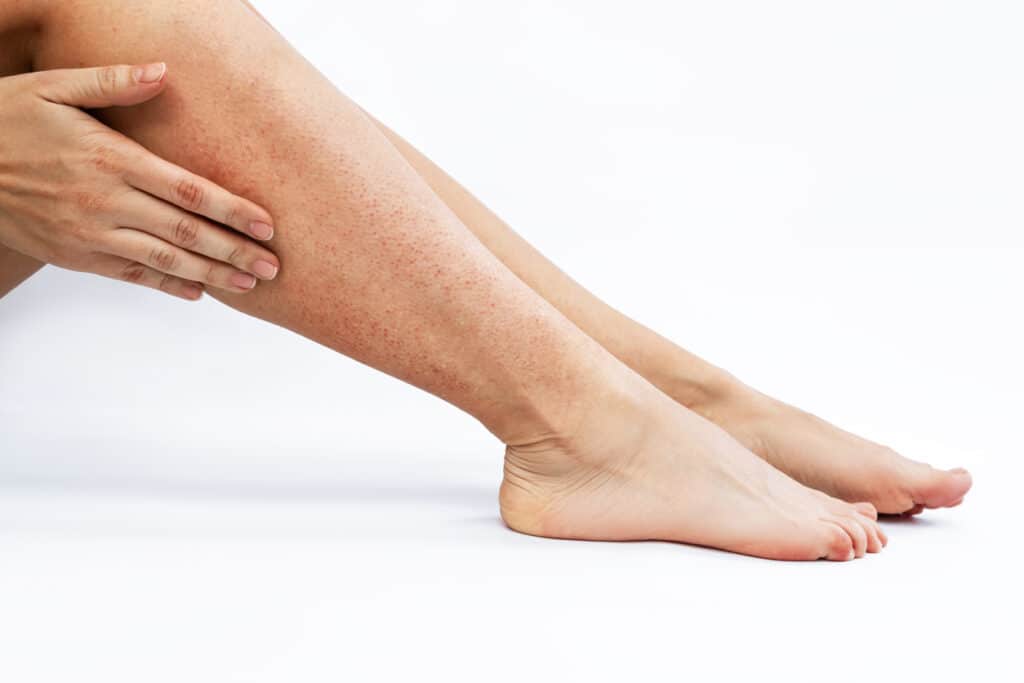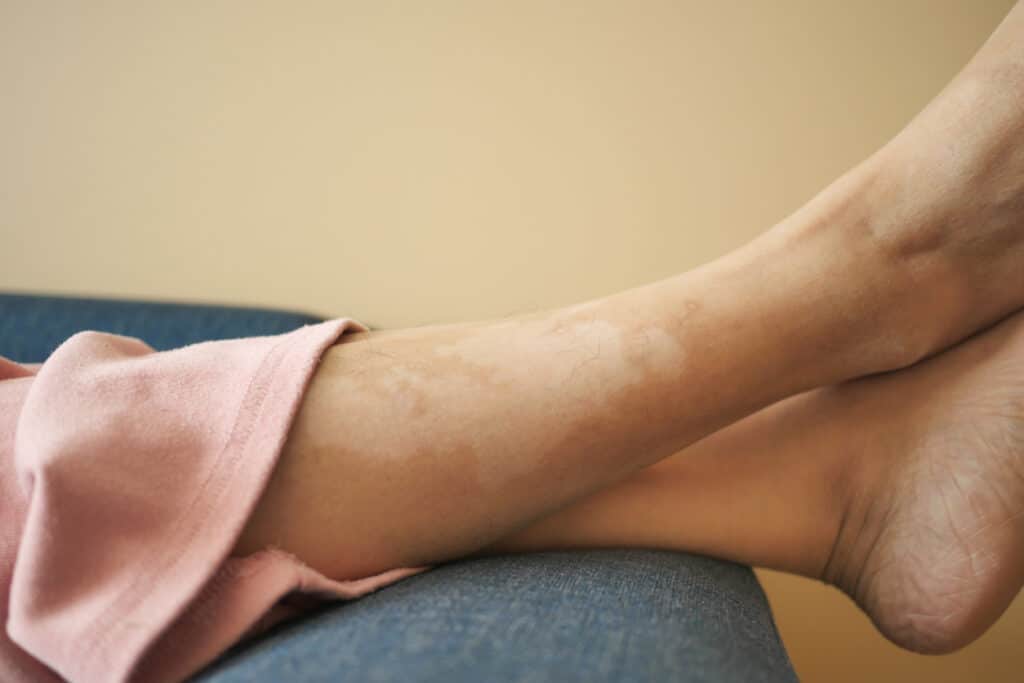Skin discoloration on legs can be a puzzling and concerning symptom. It’s often linked to vascular health, but what does that mean?
Vascular health refers to the health of our body’s circulatory system. This system made up of our heart and blood vessels, is responsible for circulating blood throughout our body. When it’s not working correctly, it can lead to various issues, including leg discoloration.
Understanding the causes of leg discoloration can be challenging, especially when faced with medical jargon. Terms like venous stasis dermatitis and peripheral vascular disease can seem daunting.
This article aims to demystify these terms and provide a clear understanding of leg discoloration. We’ll explore its symptoms, causes, and treatments and offer practical advice based on medical research and clinical practice.
By the end of this article, you’ll have a comprehensive understanding of leg discoloration and how to manage it effectively. Let’s dive in.
Demystifying Leg Discoloration
Leg discoloration refers to a change in the skin’s natural color on the legs. It can appear as brown, red, purple, or even blue patches or spots. This color change is often a sign of underlying vascular issues that need attention.
Vascular health plays a significant role in maintaining skin color. Blood flow is crucial for delivering oxygen and nutrients to the skin. When blood circulation is compromised, it can lead to changes in skin color, often seen as discoloration on legs.
Several terms frequently pop up when discussing leg discoloration. Understanding these can help demystify the condition. Here are a few common terms:
- Venous stasis dermatitis: This skin inflammation occurs due to poor blood circulation.
- Peripheral vascular disease (PVD): A condition affecting blood vessels outside the heart, particularly arteries in the legs.
- Varicose veins: Enlarged veins often seen in the legs due to faulty valves.
Demystifying these terms can shed light on the potential causes of skin discoloration on legs. Each term indicates a different vascular issue but underscores the importance of good circulation. Recognizing these terms is the first step in effectively addressing leg discoloration.
The Circulatory System and Skin Health
The circulatory system is essential for transporting blood throughout the body, ensuring each cell receives oxygen and nutrients. It involves a complex network of arteries and veins working together to maintain optimal blood flow. Proper circulation is vital for overall health and critical to skin health and appearance.
Blood flow directly affects the skin’s color and texture. When circulation is healthy, skin appears vibrant and even-toned. However, when the circulatory system is compromised, it can lead to discoloration and other skin issues. This may manifest as patches or changes in color, particularly on the legs, where circulation can be more easily affected.
Healthy blood circulation allows for the removal of waste products from skin cells. When this process is disrupted, it can result in the buildup of waste and toxins, leading to discoloration and potential skin damage. This emphasizes the importance of maintaining circulatory health for preventing skin discoloration on legs.
Issues like venous insufficiency highlight the impact of circulatory problems on the skin. Poor venous return causes blood to pool in the lower limbs, leading to increased pressure in the veins. This can result in various symptoms, including leg discoloration, swelling, and even skin ulcers if left untreated. Understanding the circulatory system’s crucial role can empower individuals to recognize and address potential health concerns related to skin discoloration on legs.
Recognizing Symptoms of Leg Discoloration
Leg discoloration can appear as a visible skin tone change, typically as dark or reddish patches. These changes often signal underlying vascular issues that require attention. As a symptom, it serves as a visible indicator that something more serious may be at play within the circulatory system.
Vascular discoloration on the legs is commonly accompanied by other symptoms, including swelling, heaviness, or itchiness. It’s essential to note these signs, as they provide additional insight into the condition. These accompanying symptoms can often highlight a pattern indicative of a vascular disorder.
Early signs of vascular disease may include persistent leg fatigue, unexplained pain, or a feeling of tightness in the calf muscles. Observing these subtle changes can aid in early detection and intervention. Prompt recognition of these symptoms is crucial, as it can significantly influence the effectiveness of subsequent treatments.
Symptoms to watch for:
- Swelling in the ankles or feet
- Persistent itching or irritation
- Changes in skin texture and color
Acknowledging these signs is the first step towards managing and treating leg discoloration. Early intervention can prevent more severe complications. Recognizing the symptoms early allows for a proactive approach in maintaining vascular health and preventing disease progression.
Unveiling the Causes of Leg Discoloration
Leg discoloration often stems from venous insufficiency, where veins struggle to efficiently return blood from the legs to the heart. This can lead to blood pooling and increased pressure in the veins, resulting in discoloration. Venous insufficiency is a common issue in patients with leg discoloration concerns.
Chronic conditions like diabetes can impair blood flow, contributing to skin discoloration on legs. Diabetes affects the circulatory system, making it a significant factor in skin changes. It’s essential to manage these chronic conditions to mitigate their impact on vascular health.
Lifestyle Choices
Lifestyle choices play a pivotal role in the health of your veins. Obesity and a sedentary lifestyle can exacerbate venous problems, leading to discoloration. Physical inactivity reduces the muscle contractions needed to help blood flow back to the heart, worsening vascular issues.
Smoking is another critical factor that adversely affects vascular health. It narrows blood vessels and damages their inner lining, impeding blood flow and increasing the risk of discoloration. Quitting smoking is essential for anyone seeking to improve their vascular health and reduce leg discoloration.
Other Factors
Varicose veins, enlarged veins commonly found in the legs and feet, can also cause skin color changes. These veins can appear twisted and bulging, contributing to discomfort and the aesthetic issues of leg discoloration. Addressing varicose veins can help alleviate these concerns.
One specific condition linked to varicose veins is venous stasis dermatitis, a form of eczema caused by poor circulation. Venous stasis dermatitis manifests as inflammation and discoloration on the skin, marking a progression from untreated venous issues. Treating the root cause can often reverse or significantly improve the skin changes associated with this condition.
Factors contributing to leg discoloration include:
- Venous insufficiency
- Chronic health conditions like diabetes
- Lifestyle factors such as obesity and inactivity
- Smoking and its effects
- Varicose veins and related conditions
Understanding these causes helps inform better treatment strategies, emphasizing the importance of early lifestyle changes and medical intervention. Identifying the root cause is essential for effective management, allowing individuals to address the condition proactively rather than reactively.
Diagnosing Leg Discoloration
Diagnosing the cause of leg discoloration begins with a thorough medical evaluation. Healthcare providers must assess the specific symptoms and underlying factors affecting each patient. A complete understanding of a patient’s medical history aids in forming an accurate diagnosis.
One of the primary diagnostic methods is the physical examination. This allows clinicians to visually and manually assess the affected area. Observing the pattern and extent of discoloration provides key insights into potential causes, such as venous insufficiency or other vascular conditions.
In addition to a physical examination, duplex ultrasound is often employed. This non-invasive test evaluates blood flow and the structure of blood vessels in the legs. It helps identify any obstructions or abnormalities, such as varicose veins or deep vein thrombosis, which could contribute to discoloration.
Blood tests may also be recommended to rule out other causes. Tests can check for diabetes, inflammation, and clotting disorders. These factors can play a role in circulatory issues leading to discoloration. Accurate testing ensures a comprehensive understanding of a patient’s condition.
A detailed medical history combined with these diagnostic tools ensures a well-rounded approach. It enables the healthcare provider to pinpoint the precise cause, guiding effective treatment planning and management.
Treatment Options for Leg Discoloration
Addressing leg discoloration often begins with conservative treatments that aim to improve circulation. Compression therapy is a standard recommendation. Wearing compression stockings can help manage symptoms by promoting blood flow and reducing swelling.
Lifestyle Changes
Lifestyle modifications play a vital role in managing leg discoloration. Regular exercise, such as walking or cycling, encourages healthy blood flow. Staying active not only helps to alleviate symptoms but also supports overall vascular health.
Dietary changes can also benefit those with vascular conditions. A balanced diet of fruits, vegetables, and whole grains supports circulation. Reducing salt intake can prevent fluid retention, often exacerbating swelling and discoloration.
Medications
Medications may be prescribed to address underlying vascular issues. Blood thinners can help prevent clot formation, while diuretics may reduce fluid buildup. These medications work to alleviate symptoms and improve leg health.
Medical Treatments
Surgical options are available for more advanced cases. Endovenous thermal ablation is a minimally invasive procedure used to treat varicose veins. It involves using heat to close off problematic veins, redirecting blood flow through healthy vessels.
Sclerotherapy is another effective treatment, especially for spider veins and small varicose veins. This procedure involves injecting a solution into the veins, causing them to collapse and fade over time. It is less invasive and often has a shorter recovery period.
Skin grafting may be considered in severe cases of venous stasis dermatitis. When skin damage is extensive, grafting healthy skin can promote healing and restore appearance.
Treatment plans are often tailored to the individual’s specific condition and severity. Close collaboration with a healthcare provider ensures the chosen treatments align with the patient’s needs and lifestyle.
Patients are encouraged to monitor their symptoms and maintain follow-up appointments regularly. Ongoing communication with healthcare providers ensures adjustments to the treatment plan are made as needed. This personalized approach increases the likelihood of successful management and symptom relief.
Managing Leg Discoloration: Practical Advice
Effective management of leg discoloration involves consistent skin care. Keeping the skin moisturized is essential. This prevents dryness and cracking, worsening discoloration and leading to infection.
Gentle cleansing is recommended to avoid irritating the skin. Use mild, fragrance-free soaps and pat the skin dry with a soft towel. This simple routine can help maintain skin health.
Protection from injury is crucial, particularly in discolored areas. Wearing long pants and protective gear during activities can help prevent cuts and bruises. These precautions reduce the risk of complications.
Practical Tips for Managing Leg Discoloration:
- Moisturize daily to maintain skin elasticity.
- Elevate legs frequently to reduce swelling.
- Wear supportive shoes to encourage good circulation.
- Use sunscreen to protect skin from UV damage.
A multidisciplinary team can provide comprehensive care for leg discoloration. Collaboration between vascular specialists, dermatologists, and primary care physicians ensures holistic treatment. This team approach addresses the various aspects of the condition.
Regular check-ins with your healthcare team are vital. They allow for monitoring progress and adjusting treatment plans as needed. Open communication with your providers enhances outcomes.
Educating yourself about your condition can empower you to make informed decisions. Understanding treatment options and their benefits can help manage expectations. This knowledge fosters a proactive approach to health care.
Incorporating stress management techniques is also beneficial. Practices like yoga or meditation can improve overall health. Reducing stress supports vascular function and skin integrity.
By integrating these strategies, individuals can effectively manage leg discoloration. Consistent care and professional support play a crucial role in maintaining skin health.
Complications and Psychological Impact
Unchecked leg discoloration can lead to serious complications. If untreated, it may cause skin ulcers. These open sores can become infected, leading to further health issues.
Chronic leg discoloration may also indicate worsening vascular disease. This progression can result in increased pain and limited mobility. Understanding these risks highlights the importance of early intervention.
The psychological impact of leg discoloration should not be underestimated. Changes in appearance can affect self-esteem. This can lead to social withdrawal and emotional distress.
Support from mental health professionals can be invaluable. Therapy can help individuals cope with the emotional challenges of chronic conditions. Counseling provides a safe space to express feelings and concerns.
Connecting with support groups can also be beneficial. Sharing experiences with others facing similar challenges fosters a sense of community, and this support can be a powerful tool in managing the physical and psychological aspects of leg discoloration.
Success Stories: Overcoming Leg Discoloration
Individual experiences can offer hope and motivation. Many patients have successfully managed leg discoloration by following tailored treatment plans. These stories highlight the power of persistence and expert guidance.
One patient, diagnosed with venous stasis dermatitis, embraced lifestyle changes. With guidance, she adopted regular exercise and dietary modifications. Her consistent efforts led to significant improvements in skin color and comfort.
Another success involved a patient with severe varicose veins. Surgical intervention, combined with compression therapy, transformed his daily life. Over time, his skin discoloration faded, and his mobility improved markedly.
These testimonials emphasize the importance of personalized care and support. Each patient’s journey illustrates how commitment and professional advice can enhance outcomes. Sharing these stories encourages others facing leg discoloration to pursue treatment confidently, understanding that improvement is achievable with the right approach.
Latest Research and the Importance of Early Intervention
Recent studies are shedding light on leg discoloration. Research emphasizes the link between vascular health and skin changes. These findings drive innovative approaches to managing the condition.
Early intervention remains crucial. Timely action can prevent worsening of symptoms and complications. Addressing underlying causes early enhances the likelihood of positive outcomes.
New studies advocate for proactive management. Patients who start treatment promptly often experience better results. Early diagnosis allows for a range of more effective treatment options.
Medical research also highlights the role of lifestyle modifications. Incorporating these changes early can significantly impact the progression of leg discoloration. Simple adjustments in daily habits can yield long-term benefits.
Experts agree that patient education and awareness are necessary. Understanding the importance of early intervention encourages individuals to seek help promptly. Empowered patients can effectively manage their condition and improve their quality of life.
Are You Experiencing Leg Discoloration? Give Coastal Vascular Center A Call!
In conclusion, leg discoloration can be a visible sign of various underlying health issues, many of which stem from vascular diseases or related conditions. Understanding the causes behind this symptom is the first critical step in addressing the discoloration itself and the potential health risks associated with it. It’s imperative to take any changes in your skin color seriously and seek professional advice to ensure any underlying conditions are caught early and managed effectively.
The Coastal Vascular Center specializes in diagnosing and treating vascular conditions that could be the root causes of leg discoloration. Our team, led by the esteemed Dr. Ayar, is committed to providing personalized care, utilizing the latest medical advancements to address symptoms and treat the underlying causes. Early intervention is critical to preventing more severe complications, and our expert care is here to guide you through each step toward healthier legs.
If you’ve noticed changes in the color of your legs, or if you’re experiencing any associated symptoms like swelling, pain, or altered sensation, don’t hesitate to reach out. Contact the Coastal Vascular Center today to schedule an appointment. Let’s take the next step together towards understanding your symptoms and uncovering a path to better vascular health. Your legs deserve the best care, and at Coastal Vascular Center, we’re here to deliver just that.




